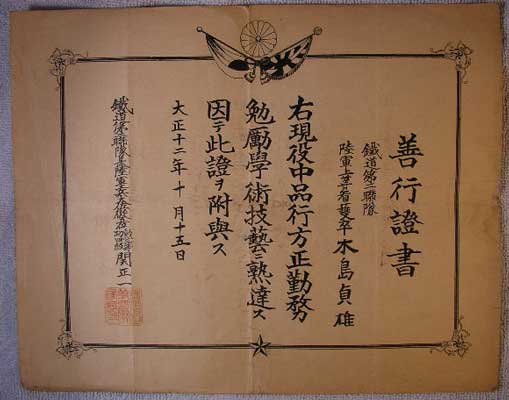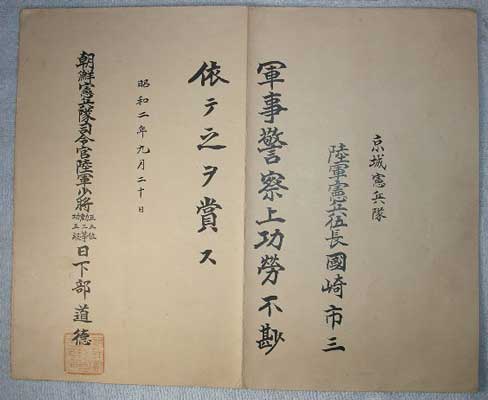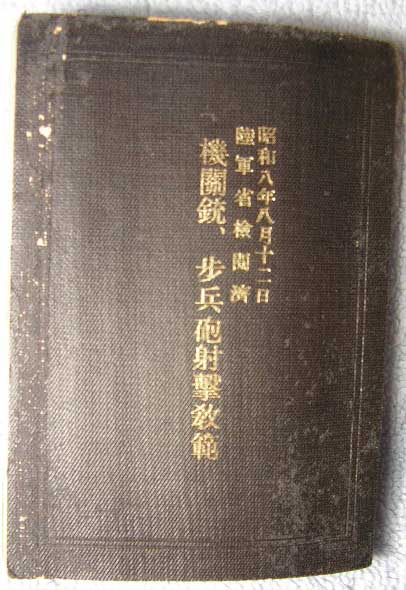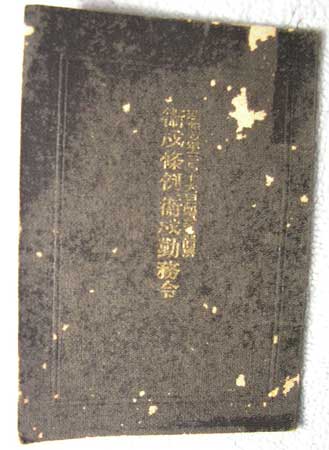Miscellaneous
Japanese Militaria
This section is for a potpourri of
military-related items from Imperial Japan (to 1945). I also have some WWII-era
magazines I will add soon.
Military
Certificates
Among the things Japanese soldiers
and reservists were to keep in their hokobukuro
(service bags) were certificates evidencing various military
qualifications. Here are three certificates for the same man, Mr. Sadao Kijima.
They are all the same size, about 9.5” by 11.5” and printed on very thick
paper, almost like card stock.
The first one is his graduation
certificate from

This is his Good Conduct (zenko) Certificate dated October 15,
Taisho 12 (1924). He was now a Superior Private, still in the second railway
regiment.

The last of these three is his
certificate of qualification as an NCO (riku-gun-ka-shi-teki-nin-sho-sho).
It is dated November 25, Showa 2 (1928). It says he is recognized as qualified
to be a hospital steward (literally, head nurse). This was an NCO ranak
position.
This certificate was issued by the Keijo Kempeitai. Keijo was what the Japanese called
Anyway, this certificate was issued
on September 20, Showa 2 (1927) to Corporal Ichizo Kunizaki for meritorious
service (koro). It bears the stamp of
the Commanding Officer of the Chosen Kempeitai, Army Major General (shosho) Michinori Hikabe.

Manuals
Like any big organization, the Army
had to have manuals to codify procedures and to facilitate training. I have
several of these Army field manuals. They are shirt- pocket size, about 75mm X
108mm (2 15/16” by 4 ¼”). The first four all belonged to the same man, Mr.
Suekichi Asano. According to his notes in the backs of two of the books, he was
assigned to the “infantry artillery battery”.

This one is ki-kan-ju, ho-hei-ho-sha-geki-kyo-han, “textbook on firing machine
guns and infantry artillery”. It is dated August 12, Showa 8 (1933) and has 194
pages plus a large number of foldouts in the back.

This one is dated January 19, Showa
7 (1932) and is entitled jin-chu-yo-mu-rei,
“important orders for being in the field”. It has over 300 pages. Like all of them
it is printed on very thin paper.

Another one with
the same date (January 19, 1932). This one is sen-to-ko-yo, “Essentials of fighting”. It has 308 pages.

The last and
thinnest of the four, with just 24 pages. Ei-ju-jo-rei-ei-ju-kin-mu-rei means garrison regulations and
garrison duty orders.

Mr.
Asano put his name stamp on the dge of the book.

This one is Riku-gun-en-shu rei,
“Regulations for Army Manouevres”. It is dated January 28, Showa 4 (1929). The
name Konishi is handwritten in pencil in fine cursive English handwriting in
the back.

This
manual is entitled Hohei soten, “Infantry drill”. It is dated February 25,
Showa 15 (1940). It has 376 pages and a couple of fold-out diagrams in the
back.

The
title of this one is Kaisei zaigo
gunjinkai kokoroe, “Revised Rules of the Imperial Reservists’ Association”.
It was issued on January 8, Taisho 1 (1911). I didn’t notice at first, but the
back has some cursive handwriting that seems to indicate 20th Regiment,
1st Company, Mr. Ueda. His given name
started with Kiyo-, but I can’t make out the last two characters. The piece of
paper glued to the upper right corner of the front cover seems to have a red
name stamp on it, but it is too faded to read.

Greater
Japan Defense Women’s Association
This association was set up to
mobilize Japanese women to support the Reservists’ Association and other
military organizations and events around

The other side of the left part says
bun-kai, “local chapter”. Normally
the name of the town would be hand written above this.

Here is the label. It’s pretty
blurry. Right now all I can make out is

Last
updated: November11, 2004. All contents are copyright Teri unless otherwise
specified and may not be used elsewhere in any form without prior permission.
Click here to go back to the Other Militaria
page: Teri's Japanese
Handgun Website: Other Japanese Militaria
Click here to go back to the main page: Teri’s Japanese Handgun Website
6